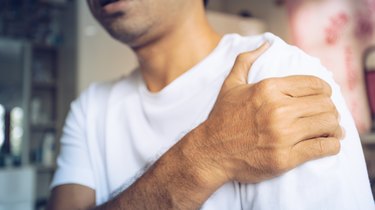
When blood vessels, which carry blood throughout your body, get injured, clots form to stop the bleeding. As you heal, your body should absorb the clots and they should dissolve. Sometimes, however, these clots remain and restrict the flow of blood behind them.
A clot that forms in a major vein is called a deep vein thrombosis (DVT). Though DVTs are most likely to form in the deep veins of your legs, they also can form in your arms, according to the American Society of Hematology (ASH). It's even possible for them to develop in your pelvis or other deep veins as well.
Video of the Day
Video of the Day
Symptoms of a Blood Clot in the Arm
DVT in your arms or elsewhere can be life-threatening. "DVT in the arm is less common than in the legs," says Melissa Baldwin, MD, an assistant professor of surgery at the Icahn School of Medicine at Mount Sinai in New York City. But it is equally disconcerting, she adds. As many as 100,000 Americans die each year from DVT, according to the ASH.
This makes it important to know the signs of a blood clot in your arm and to seek medical attention right away if you experience them, according to the National Blood Clot Alliance.
"DVT in your arm often presents with swelling and pain," Dr. Baldwin says. Your hand as well as much of your arm may look swollen. The swelling is likely to be just in the one arm and starts where the clot has formed. Swelling is most likely to occur if the blood clot is in a vein that is close to the surface of your skin, according to the Indiana Hemophilia & Thrombosis Center.
The pain from a blood clot in your arm feels like cramping. This results from the clot blocking the vein and reducing the amount of oxygen it gets.
Discoloration is another possible symptom of a blood clot in the arm. The skin on your arm may look red, purplish or bluish around the area of the clot. "The discoloration is due to venous congestion," Dr. Baldwin says. That's when the flow of blood into the vein is greater than the flow out. The skin around the clot may be warm to the touch.
Causes of a Blood Clot in the Arm
According to the National Blood Clot Alliance, a number of risk factors could be to blame:
- Surgery or an injury to veins and arteries
- Smoking
- Obesity
- Pregnancy or hormone therapy
- Age — being over 60
- Cancer or cancer treatment
- Family history of blood clots
Young competitive athletes may be particularly susceptible to a blood clot in an armpit, according to the Cleveland Clinic. When you use your arm repeatedly, your collarbone, first rib or surrounding muscle can compress veins in your armpit or in the front of your shoulder (the subclavian vein). When a vein is compressed, it can become inflamed and, over time, fibrous tissue can build up, making the vein too narrow for a normal amount of blood to flow through. The result is a clot.
"Patients with chest or arm implants such as a pacemaker, defibrillator or catheter also can develop blood clots in their arms," Dr. Baldwin says.
Read more: Muscles Affected by Sitting All Day
Treating a Blood Clot in the Arm
While there are some self-care steps you can take, like keeping your arm elevated above your heart to reduce swelling and pain, a blood clot should always be evaluated by your doctor.
The doctor may prescribe a blood thinner. This medication will help stop the clot from growing and traveling to another part of your body, such as your lung, where it can do serious damage, according to the Cleveland Clinic.
You may need to wear a compression sleeve to increase blood flow from your hand to your heart. Physical therapy and home exercises could also be part of the plan.
If these steps don't resolve the problem, your doctor may suggest delivering clot-busting medication into the clot itself via a catheter or surgically removing it, according to ASH.
Read more: List of Blood-Thinning Foods
- National Blood Clot Alliance: “About Blood Clots”
- American Society of Hematology: “Blood Clots”
- Melissa Baldwin, MD, assistant professor, surgery, Icahn School of Medicine, New York.
- Cleveland Clinic: “Axillo-Subclavian Vein Thrombosis”
- Indiana Hemophilia and Thrombosis Center: “Signs and Symptoms of Blood Clotting”
Is this an emergency? If you are experiencing serious medical symptoms, please see the National Library of Medicine’s list of signs you need emergency medical attention or call 911.